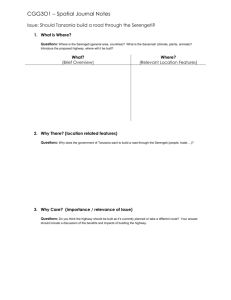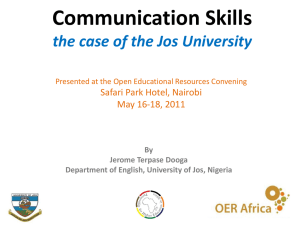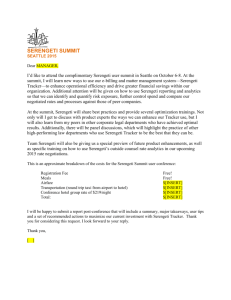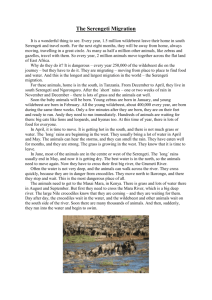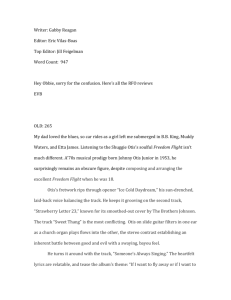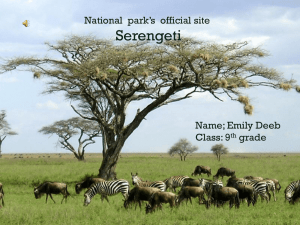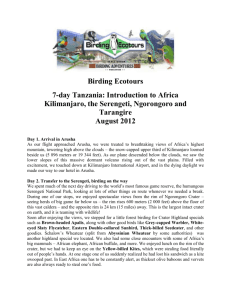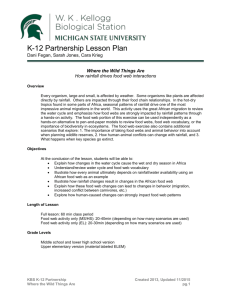Socio-Economy of Serengeti pilot
advertisement
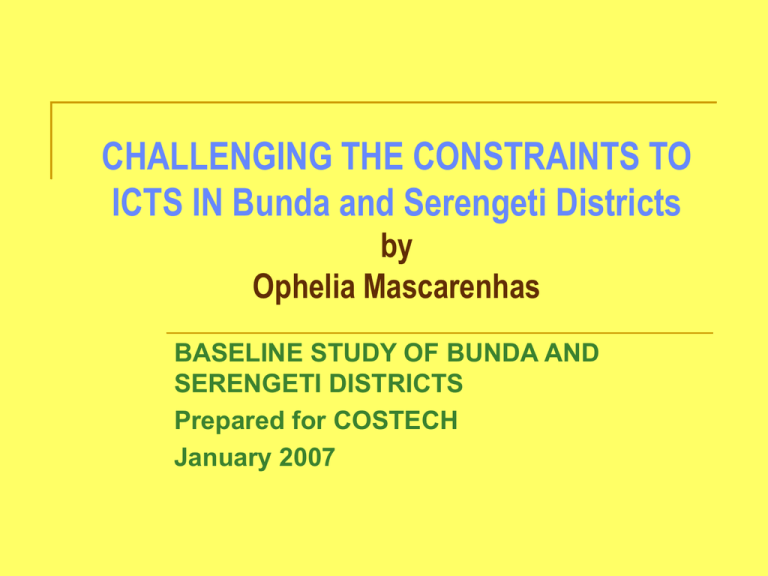
CHALLENGING THE CONSTRAINTS TO ICTS IN Bunda and Serengeti Districts by Ophelia Mascarenhas BASELINE STUDY OF BUNDA AND SERENGETI DISTRICTS Prepared for COSTECH January 2007 Baseline Study of Bunda and Serengeti Districts Background to the Study ICT4RD objective Opportunity to achieve the objective Links with the KTH study National ICT Framework Good developments in cellular telephones Less spectacular in Internet The Opportunity Provided by the Rural Electrification Project in Bunda and Serengeti Districts The famous optic fibre; empty at the moment and waiting for the promised broad band Let Us Start With Images Some Recent Studies Many studies on ICTs and poverty and the use of ICTs – RIA, DFID For Mara Region study involving the use of ICTs in 150 SME’s in Dar es Salaam, Arusha, Mwanza, Zanzibar, and Mara found that in Mara, there was virtual “inexistence of any cell phone or internet services.” (2001) Most assessments not based on pre-ICT intervention situations Bungalows & Herds-boys in Jeans Objectives of the Study To provide a pre-project situation analysis of the socio-economic conditions of the 12 villages in the 2 districts, Bunda and Serengeti with special emphasis on (but not limited to) education, health and local administration and small and medium enterprises (SME’s). To obtain an understanding of the level of current use of communication systems including ICTs in the two districts. , Methodology Villages Bunda District: Manyamanyama, Ligamba “A”; Kisangwa; Bukama; Kiroleli; Mugeta; Salama “A”; Kyandege 54 km. Serengeti District: Fort Ikhoma; Natta; Nyichoka; Nyeberekera; Nyamsingisi Plus 2 district headquarters Persons Interviewed District Council Staff: 8: ( 1 each – DPLO; DEO; DMO; District Trades Officer) Heads of Private and Public Educational institutions: 8 Heads of Health institutions: 3 Other institutions (Head of Fort Ikhoma) 1 Villagers: 104 in 11 villages; Business people: 71 (47 in Bunda Town and Mgumu Town; 24 in the villages) Total number of persons interviewed individually or in groups: 195. Socio-economic conditions The Economic Conditions The FDI for Mara has declined between 1999 and 2001 Total revenue for Serengeti District in 2005 was Tanzanian shillings 4.4 billion, of which 95 per cent came from the central government. Produce cess on exports was only 1. 2 per cent while mining and tourism were not even mentioned. Yet one of the most famous national game reserves in the world is in Serengeti District and the District is said to be rich in a variety of minerals. Socio-economic conditions II As a result of these anomalies, the last Household Budget Survey, 2000/01, ranked Bunda district as the poorest district in Tanzania, 119th out of 119 districts, a fact that was commented on by the President just recently. Serengeti is a close second at 116th out of 119 districts. Socio-economic conditions This ranking is both disturbing and surprising. The research team made several observations that somehow do not match the poverty ranking status. : (i) there was a vibrant small business activity; (ii) Large herds of cattle were observed, particularly in Serengeti District; (iii) The majority of the villages had more than 3 maize mills and some even as many as 6 maize mills – all operating on diesel. The Largest Lake in Africa but Bunda has little water & there is even some History Less than half the population of Bunda has protected water supplies With the right investment and policies this historical site can be an asset for Serengeti District Indicators of Poverty or Wealth Business Women & Fantastic Sunsets Females play a significant role in the informal economy in Serengeti district The beauty of the landscapes of Mara are reflected in the sunsets PLASTICS & Vibrant Local Markets There is a demand for basic consumer goods but even more interesting Is the VIBRANT weekly traditional market in Mgumu Township …… there is a surplus Information and Communications Increasing use of the mobile telephone No internet ISPs in either district and no internet cafes Internet being used in the district at own premises or in cybercafes outside the districts On Premises District Council offices Some big businesses Institutions (e.g. DDH in Bunda district) Information and communication Off premises Businesses Institutions Individuals Sector use LGA Education Health SME’s Public Access to IT in the Urban Area and a Rural ICT Public access to telephony in Bunda Town BUT Even rural HHs do invest in improved housing and ICT Satellite Dishes & Cross Country Buses in the Rural Areas Village Shop & Bar/ Restaurant……ICT the hidden persuader; Links with neighbours in Arusha, Mwanza, Nairobi Count the Dishes … Pampering the Staff or Globalization? A good comfortable life for TANAPA Staff ….. Given the resources of Mara… this type of comfort zone is possible for many, many more. Impossible if people are excluded from rights to their resources and development Where do Tanzanians invest? Good Private Schools are an indication of unequal growth! However, they are potential users of the broadband Mara is the playground of Billionaires in US $; More and more land is for National Parks and Foreign Gold Mining Interests Getting out of poverty, means investing in education and schools; Joining hands with the private sectors; Taking Advantage of technological development; Transparent enough to encourage people Development with evictions and oblivious to the needs of people leads to illusive development Implications of the Findings There is a demand for cheaper and more effective ICTs. Currently large sums of money are being used on mobiles and on travel to do business The indications of the demand seem to indicate that internet services can be operated on a self-sustaining business basis The initial clients are the district council, the better off business people and the private educational, health and financial institutions, financial institutions like Pride and NGO’s The mobiles will continue to be popular so interventions will need to take into account the need for voice as well as other uses of the broadband Challenges The survey has raised people’s expectations; how will these expectations be met? Who will lead the process? Who will participate? There is need to consider ICTs within the current national policy of enhancing SME’s. Can some of the 1 billion shillings be used to start at least one public access internet café in each district? At least two persons in Serengeti District are currently involved in such business in Musoma. How can they be persuaded to open similar businesses in Bunda and Mgumu? The Way Forward For the baseline study the way forward to complete the analysis, fill in any gaps and finish and disseminate the report For Bunda and Serengeti the first priority is to use the optic fibre for providing voice and non voice ICT services THANK YOU FOR LISTENING
